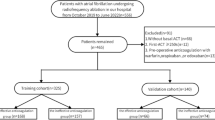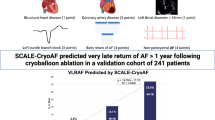Abstract
Purpose of Review
We performed this study and associated review to examine whether a one prognostic block is sufficient to proceed with radiofrequency ablation.
Recent Findings
To perform one or two prognostic blocks before performing radiofrequency ablation is a very controversial issue. The practice is inconsistent and insurance companies even do not follow same regulations.
Summary
We found in our research that majority of patients who receive a successful first prognostic block also receive a successful second prognostic block. We think one prognostic block can be sufficient to move forward with radiofrequency ablation.
Similar content being viewed by others
References
Papers of particular interest, published recently, have been highlighted as: • Of importance
Institute of Medicine Committee on Advancing Pain Research, Care, and Education. Relieving pain in America, a blueprint for transforming prevention, care, education and research. Washington DC: The National Academies Press; 2011.
Dieleman JL, Squires E, Bui AL, Campbell M, Chapin A, Hamavid H, et al. Factors associated with increases in US health care spending, 1996-2013. JAMA. 2017;318:1668–78.
Manchikanti L, Hirsch JA, Falco FJ, Boswell MV. Management of lumbar zygapophysial (facet) joint pain. World J Orthop. 2016;7:315–37.
• Gaskin DJ, Richard P. The economic costs of pain in the United States. J Pain. 2012;13:715–24 A very important study as it discusses the economic burden of pain management.
Dawson J, Linsell L, Zondervan K, Rose P, Randall T, Carr A, et al. Epidemiology of hip and knee pain and its impact on overall health status in older adults. Rheumatology. 2004;43:497–504. https://doi.org/10.1093/rheumatology/keh086.
• Choi WJ, Hwang SJ, Song JG, Leem JG, Kang YU, Park PH, et al. Radiofrequency treatment relieves chronic knee osteoarthritis pain: a double-blind randomized controlled trial. Pain. 2011;152:481–4877 An important study as it was one of the first to describe one of the most widespread performed RFA procedures.
Iannaccone F, Dixon S, Kaufman A. A review of long-term pain relief after genicular nerve radiofrequency ablation in chronic knee osteoarthritis. Pain Physician. 2017;20:E437–44.
Schwarzer AC, Aprill CN, Derby R, Fortin J, Kine G, Bogduk N. The false-positive rate of uncontrolled diagnostic blocks of the lumbar zygapophysial joints. Pain. 1994;58:195–200.
Waldman S, Rosenthal R. Pain management. 2nd ed. Philadelphia: Elsevier Inc; 2011.
Leggett LE, Soril LJ, Lorenzetti DL, Noseworthy T, Steadman R, Tiwana S, et al. Radiofrequency ablation for chronic low back pain: a systematic review of randomized controlled trials. Pain Res Manag. 2014;19:e146–53.
Cosman ER Jr, Cosman ER Sr. Electric and thermal field effects in tissue around radiofrequency electrodes. Pain Med. 2005;6:405–24.
Bogduk N. Pulsed radiofrequency. Pain Med. 2006;7:396–407.
Eerd M, Kleef M, Zundert J. Practical management of pain. 5th ed. Philadelphia: Elsevier Inc; 2015.
Derby R, Melnik I, Lee JE, Lee SH. Cost comparisons of various diagnostic medial branch block protocols and medial branch neurotomy in a private practice setting. Pain Med. 2013;14:378–91.
Manchikanti L, Singh V, Pampati V, Smith HS, Hirsch JA. Analysis of growth of interventional techniques in managing chronic pain in the Medicare population: a 10-year evaluation from 1997 to 2006. Pain Physician. 2009;12:9–34.
Manchikanti L. The growth of interventional pain management in the new millennium: a critical analysis of utilization in the Medicare population. Pain Physician. 2004;7:465–82.
Schwarzer AC, Aprill CN, Derby R, Fortin J, Kine G, Bogduk N. Clinical features of patients with pain stemming from the lumbar zygapophysial joints. Is the lumbar facet syndrome a clinical entity? Spine. 1994;19:1132–7.
Bogduk N. International Spinal Injection Society guidelines for the performance of spinal injection procedures. Part 1: zygapophysial joint blocks. Clin J Pain. 1997;13:285–302.
Bogduk N. Evidence-informed management of chronic low back pain with facet injections and radiofrequency neurotomy. Spine J. 2008;8:56–64.
• Cohen SP, Williams KA, Kurihara C, Nguyen C, Shields C, Kim P, et al. Multicenter, randomized, comparative cost-effectiveness study comparing 0, 1, and 2 diagnostic medial branch (facet joint nerve) block treatment paradigms before lumbar facet radiofrequency denervation. Anesthesiology. 2010;113:395–405 An important study as it provides a prospective on performing 2 blocks.
Bogduk N, Holmes S. Controlled zygapophysial joint blocks: the travesty of cost-effectiveness. Pain Med. 2000;1:24–34.
Centers for Medicare and Medicaid Services (CMS). Fee schedule. 2018. Available at: https://www.cms.gov/. Accessed September 10, 2018.
McCormick ZL, Reddy R, Korn M, Dayanim D, Syed RH, Bhave M, et al. A prospective randomized trial of prognostic genicular nerve blocks to determine the predictive value for the outcome of cooled radiofrequency ablation for chronic knee pain due to osteoarthritis. Pain Med. 2018;19:1628–38.
Reddy RD, McCormick ZL, Marshall B, Mattie R, Walega DR. Cooled radiofrequency ablation of genicular nerves for knee osteoarthritis pain: a protocol for patient selection and case series. Anesth Pain Med. 2016;6(6):e39696.
Kornick C, Kramarich SS, Lamer TJ, et al. Complications of lumbar facet radiofrequency denervation. Spine. 2004;29:1352–4.
Author information
Authors and Affiliations
Corresponding author
Ethics declarations
Conflict of Interest
Emily Narel and Michael Loebertman declare no conflict of interest. Dr. Abd-Elsayed is a consultant for Medtronic, Avanos, StimWave, Sollis.
Human and Animal Rights and Informed Consent
This article does not contain any studies with human or animal subjects performed by any of the authors.
Additional information
Publisher’s Note
Springer Nature remains neutral with regard to jurisdictional claims in published maps and institutional affiliations.
This article is part of the Topical Collection on Neuropathic Pain
Rights and permissions
About this article
Cite this article
Abd-Elsayed, A., Narel, E. & Loebertman, M. Is a One Prognostic Block Sufficient to Proceed with Radiofrequency Ablation? A Single Center Experience. Curr Pain Headache Rep 24, 23 (2020). https://doi.org/10.1007/s11916-020-00858-8
Published:
DOI: https://doi.org/10.1007/s11916-020-00858-8




